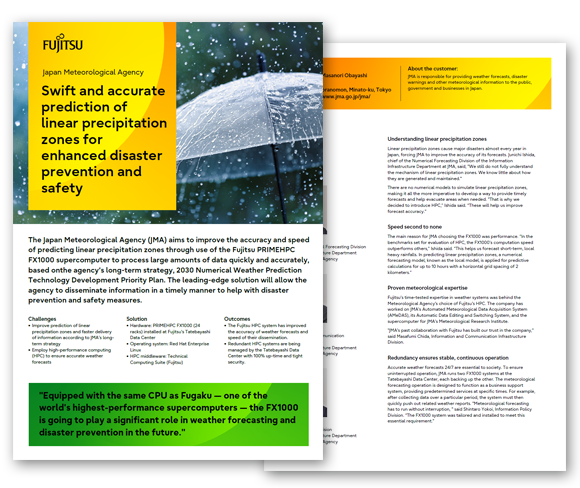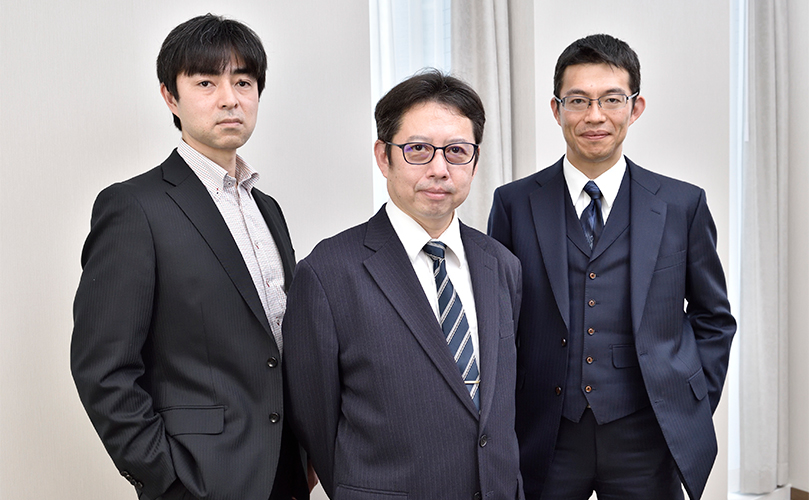Japan Meteorological Agency
Swift and accurate prediction of linear precipitation zones for enhanced disaster prevention and safety
The Japan Meteorological Agency (JMA) aims to improve the accuracy and speed of predicting linear precipitation zones through use of the Fujitsu PRIMEHPC FX1000 supercomputer to process large amounts of data quickly and accurately, based onthe agency’s long-term strategy, 2030 Numerical Weather Prediction Technology Development Priority Plan. The leading-edge solution will allow the agency to disseminate information in a timely manner to help with disaster prevention and safety measures.
Challenges
- Improve prediction of linear precipitation zones and faster delivery of information according to JMA’s long-term strategy
- Employ high-performance computing (HPC) to ensure accurate weather forecasts
Solution
- Hardware: PRIMEHPC FX1000 (24 racks) installed at Fujitsu's Tatebayashi Data Center
-
Operating system: Red Hat Enterprise Linux
- HPC middleware: Technical Computing Suite (Fujitsu)
Outcomes
- The Fujitsu HPC system has improved the accuracy of weather forecasts and speed of their dissemination.
- Redundant HPC systems are being managed by the Tatebayashi Data Center with 100% up-time and tight security.
Equipped with the same CPU as Fugaku — one of the world's highest-performance supercomputers — the FX1000 is going to play a significant role in weather forecasting and disaster prevention in the future
Accuracy enhanced
200%
- Established : 1871
- Director-General: Masanori Obayashi
- Employees : 4,500
- Location: 3-6-9 Toranomon, Minato-ku, Tokyo
- Customer's website

About the customer
JMA is responsible for providing weather forecasts, disaster warnings and other meteorological information to the public, government and businesses in Japan.

Understanding linear precipitation zones
Linear precipitation zones cause major disasters almost every year in Japan, forcing JMA to improve the accuracy of its forecasts. Junichi Ishida, chief of the Numerical Forecasting Division of the Information Infrastructure Department at JMA, said, "We still do not fully understand the mechanism of linear precipitation zones. We know little about how they are generated and maintained.
"There are no numerical models to simulate linear precipitation zones, making it all the more imperative to develop a way to provide timely forecasts and help evacuate areas when needed. "That is why we decided to introduce HPC,” Ishida said. “These will help us improve forecast accuracy."
Speed second to none
The main reason for JMA choosing the FX1000 was performance. “In the benchmarks set for evaluation of HPC, the FX1000’s computation speed outperforms others,” Ishida said. “This helps us forecast short-term, local heavy rainfalls. In predicting linear precipitation zones, a numerical forecasting model, known as the local model, is applied for predictive calculations for up to 10 hours with a horizontal grid spacing of 2 kilometers.”
Proven meteorological expertise
Fujitsu's time-tested expertise in weather systems was behind the Meteorological Agency's choice of Fujitsu's HPC. The company has worked on JMA's Automated Meteorological Data Acquisition System (AMeDAS), its Automatic Data Editing and Switching System, and the supercomputer for JMA’s Meteorological Research Institute.
"JMA's past collaboration with Fujitsu has built our trust in the company," said Masafumi Chida, Information and Communication Infrastructure Division.
Redundancy ensures stable, continuous operation
Accurate weather forecasts 24/7 are essential to society. To ensure uninterrupted operation, JMA runs two FX1000 systems at the Tatebayashi Data Center, each backing up the other. The meteorological forecasting operation is designed to function as a business support system, providing predetermined services at specific times. For example, after collecting data over a particular period, the system must then quickly push out related weather reports. "Meteorological forecasting has to run without interruption, " said Shintaro Yokoi, Information Policy Division. “The FX1000 system was tailored and installed to meet this essential requirement."
More accurate predictions of linear precipitation zones
As the FX1000 ramps up operation, JMA hopes to increase the accuracy of linear precipitation zone predictions. "We aim to forecast up to 18 hours in advance compared with the current 10 hours by the end of fiscal 2023, and also reduce the horizontal grid spacing from the current 2 km to 1 km by fiscal 2025," said Ishida.
To cope with the uncertainty of predicting linear precipitation zones, JMA is looking to employ what is known as a local ensemble forecast — a probabilistic prediction based on multiple local models set for different conditions and measurement variations. To achieve more accuracy in its initial predictions, JMA is also planning to incorporate observation data such as microwave radiometers, AMeDAS humidity sensors, and dual-polarization Doppler radars into local and mesoscale models.
"We'd like to identify the areas of heavy rain risk at the prefecture level for the next fiscal year,” Ishida said. “And by fiscal 2026, we hope to be able to provide highly accurate information about linear precipitation zones a few hours in advance.”
"Given that weather is having an increasingly significant impact on society and the economy, there are now more opportunities than ever for Fujitsu computing to contribute to weather forecasting,” he said.
As climate change becomes one of the world’s most pressing issues, Fujitsu’s computing technology for meteorological forecasting will deliver more value — both to the Japan Meteorological Agency and the country’s populace.








